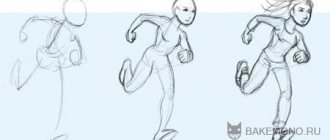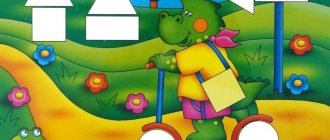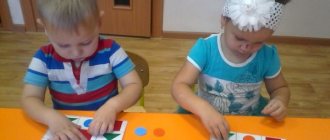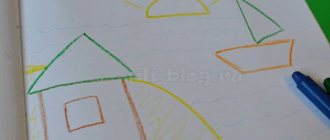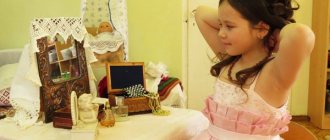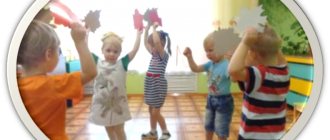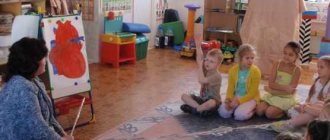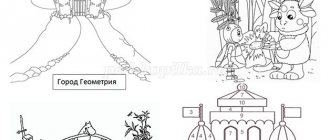At what age can you start learning geometric shapes?
A child’s knowledge of the world around him begins with his perception of objects and phenomena. At a very young age, children are not yet able to understand the shape of an object separately from itself. In fact, they experience them using various senses: not only by sight, but also by touch, as well as by pronouncing various words.
Study Kit
For your information! Comparison plays an important role in this process. Having seen a new object, the baby can determine whether it is similar to others already known to him.
In the process of development, a child perceives the geometric shape of objects differently. Small children see and feel them as a whole, without highlighting the shape. That is, each ball is not a ball for them, but a special object.
At an older age, the baby can already compare objects, determining their similarity or difference. Gradually he learns to properly highlight the elements of the form. In older preschool age, he already understands what a geometric figure is and what properties it has.
However, the development of geometric perception and thinking does not occur automatically, but through the learning process.
It is important to note that obtaining initial geometric knowledge and learning to count is for informational purposes only. At the same time, there is no systematic study of geometric knowledge. No precise definitions are considered at this time.
Important! In the process of studying, children learn to recognize and study figures, draw them, and describe them in Russian.
Geometry problems for preschoolers
Administration of the municipality
urban district "Vorkuta"
Municipal budgetary preschool educational institution
“Combined kindergarten No. 11 “Katyusha”, Vorkuta
Senior teacher
“Stick, stick, cucumber - it turned out to be a little man” - this is how kids begin to get acquainted with... mathematics. This line of the song is an example translated into children's language, illustrating: “The diagram of an object consists of the following components.” When starting to develop a child and introduce him to the world of mathematics, we all probably want the child not just to “get ready for school,” but to actually become interested in mathematics and UNDERSTAND this science. To achieve success in this field using math games for preschoolers, it is important to consider the following. The language of mathematics is a language of abstraction, logic and symbol. In order to truly understand this science, subsequently be successful in school, and learn to solve problems, the child first of all needs to UNDERSTAND, and not LEARN, what is being discussed.
The task of parents is not to ensure the process of mechanical reproduction of what has been memorized, not to suggest the right solution or answer, but to suggest the need for reflection and the process of finding an answer in principle.
And one more important condition for any activity, not just mathematics: it must remain a game. In a mathematical game, the interest of a child is awakened, which, with the right parental support, then “cannot be killed” even by an ineffective teaching system or not the best teacher.
To conduct mathematical games for preschoolers, it is not necessary to create special conditions - the world around us and everyday life provide us with a lot of opportunities for this.
Geometry for preschoolers
What we can? Introduce the child to various geometric shapes, teach him to see the geometric shapes of real objects, draw up diagrams and figures - both planar and volumetric, and modify them.
At home and on the street.
-we start with definitions of the shapes of surrounding objects (“The plate has the shape of a circle. The ball has the shape of a ball”),
- We ask you to find three objects in the kitchen that have the shape of a circle or a triangle. We gradually complicate the task, and the child in the space surrounding him must find three objects of the same shape and the same color, or several objects of the same shape, but one is smaller than the other.
-From scrap materials (beans, cubes, pebbles, twigs, ribbons, threads) we work with figures:
-make different shapes
-compose figures of the same and different shapes and sizes
-by rearranging, adding and subtracting elements, we achieve the transformation of one figure into another.
-we complicate the previous game using counting sticks (or matches): we make 2 equal triangles from 5 sticks, 2 equal squares from 7 sticks, 3 equal triangles from 7 sticks, 4 equal triangles from 9 sticks, etc.
— we are engaged in origami - one of the best arts for developing “geometric” skills.
Toys.
— The very first toy that introduces a child to shapes is, of course, cubes and pyramids
— With the help of special boards, frames and inserts, where it is necessary to place each part in “its own” nest, the baby learns to distinguish between different shapes, sizes, etc.
- The next stage is construction sets - wooden, soft, waterproof (for the bath), magnetic (they perfectly develop not only visual-figurative thinking, but also fine motor skills - try, build a three-dimensional figure from particles that strive to move apart in different directions)
— With the help of various mosaics and tablets, we improve the ability to assemble diagrams of objects from point elements and entire geometric shapes.
- We play board games that introduce geometric bodies - for example, “Shapes”, “Shapes”
— Putting together geometric puzzles is a real treasure trove for developing children’s skills and abilities.
In addition, we bring to your attention geometric tasks that, with their brightness, will definitely interest your child and help to consolidate geometric shapes.
Connect
figures of the same type according to the degree of increase their size .
Show in the picture a big red circle, a small green square,
small yellow circle, large blue triangle, large
green triangle, etc.
Find a part that matches the color and shape of each circle.
Find a picture in which the blue circle is to the left of the red square, and the yellow triangle is to the right of the red square. Tell us how the figures are located in other drawings.
Find differences
Make the same drawings from counting sticks
Look at these geometric shapes. Why are some of them called triangles and others quadrilaterals?
Show all the triangles first and then the quadrilaterals.
Find the shapes
Find and show 5 triangles and 1 quadrilateral in the drawing. Show the shapes by tracing along the outline.
?? ?
Choose the right one
Name the shape, color and size of each figure
Find all the rhombuses
Find all the same shapes
· dddllllllllllllllllllllllllllllllllllllllllllllllllllllllllllllllllllllllllllllllllllllllllllllllllllllllllllllllllllllllllllllllllllllllllllllllllllllllllllllllllllllllllllllll
Get text
